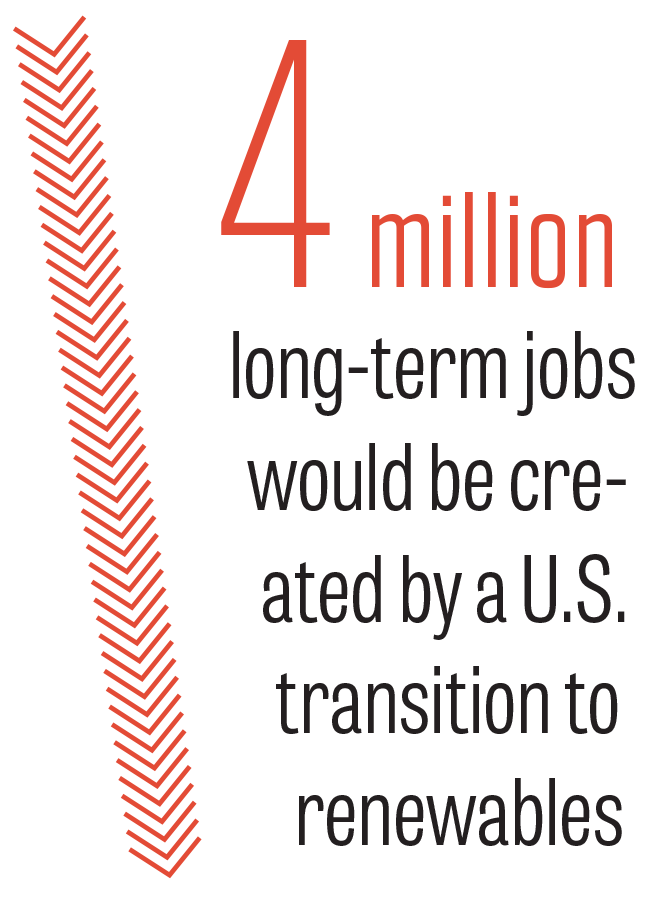Making the Green New Deal Work for Workers
A true just transition means robust training, guaranteed jobs and pensions for fossil fuel industry workers.

Making the Green New Deal Work for Workers
A true just transition means robust training, guaranteed jobs and pensions for fossil fuel industry workers.

April 22 | May 2019 Issue
The Green New Deal presents the American working class with the greatest opportunity for improving our lives and gaining power since the original New Deal of the 1930s. Responding to climate change will require the creation of millions of jobs, from pipefitters and machinists to scientists and educators, which has the potential to establish a new policy framework that makes workers’ rights and organizing central to the way our economy works.
But currently, the Green New Deal exists only as an outline of goals—as usual, there are some devils in the details. If fossil fuel use is eliminated, then workers who extract, process, transport and use fossil fuels are likely to lose their jobs. If a zero-carbon airplane can’t be built, workers in aviation—not to mention the military—will also face losses. If eliminating the use of fossil fuels were to lead to mass economic disruption, then all workers would suffer.
Of course, when economies and industries are destabilized, some workers suffer more than others. Under the established patterns, workers who currently experience racial and gender discrimination would continue to have less access to better jobs. And should the new climate-safe economy replace good jobs with poor ones, then workers who take those new jobs will receive little benefit while the conditions of their fellow workers would be subject to downward pressure. Green New Deal labor strategies must address all of these concerns in an integrated way.
The original New Deal of the 1930s was not a single program or piece of legislation—it was a whole era of turmoil. Besides its famous alphabet soup of federal agency names, the New Deal included experimentation at state, regional and local levels; organizing by unemployed, rural, urban, elderly and other grassroots constituencies, as well as labor; and lively debate on future alternatives that went far beyond the policies actually implemented. The Green New Deal will require a similar process of social change—and labor can play a powerful role in shaping it.
•
Currently, organized labor is divided on the Green New Deal. A March letter by 10 unions on the AFL-CIO’s en-ergy committee said that, while energy efficiency initiatives and strong labor standards were needed, the Green New Deal resolution is “far too short on specific solutions” and “could cause immediate harm to millions of our members and their families.” On the other hand, central labor councils in California’s San Diego and Imperial counties and Los Angeles County have endorsed the Green New Deal, as have the large 32BJ and 1199 locals of the SEIU. “We reside in coastal cities that have been flooded by storms like Hurricanes Sandy and Maria, so we know this kind of ambitious, large-scale vision to reduce greenhouse gases and switch to renew-able energies is both doable and indis-pensable,” reads 32BJ’s statement. “This is an opportunity to tackle economic inequality and reindustrialize America with a green economy through jobs that, with the right training, can provide career ladders for many low-wage workers who struggle to afford the high cost of living.”
An analysis by the Solutions Project found that a transition to 100 percent renewables would create 4 million long-term jobs and millions more short-term jobs—more, in total, than would be lost. Already, clean ener-gy jobs outnumber fossil fuel jobs 3 to 1. But to compensate workers who lose jobs in fossil fuel-related industries and to aid fossil-fuel-dependent communities, new labor policies will be needed.
While the Green New Deal resolution acknowledges this need, actual legislation will require more details. To get a new start in life, those who lose their jobs will need a significant cushion and transition period. Workers harmed by climate protection policies should receive full wages and benefits for at least four years, accompanied by access to no-cost education or training. Those ready to retire should be offered pensions with healthcare.
The education and training would harmonize with the need to develop new labor force capabilities for the emerging green economy. It could also help distribute good jobs more justly. The U.S. workforce has long been divided into a low-wage, low-quality job sector in which people of color, women, youth and other marginalized groups have been concentrated, and a higher-wage, more secure sector that disproportionately includes white men. By giving priority to those who have been excluded from better training and jobs, the Green New Deal could help end these inequalities.

•
The Green New Deal resolution calls for the government to guarantee a job for anyone who wants one, another counter to the concern that climate protection may lead to job losses. This “jobs for all” program, or “climate jobs guarantee,” builds from the concept of the federal government as the employer of last resort. Recent proposals envision a federal program to provide funds for nonprofit organizations, local governments and other public-service agencies to employ anyone who wants a job at approximately $15 an hour plus health insurance and other benefits, similar to the New Deal’s Works Progress Administration.
Such a jobs guarantee is possible because the transition to a climate-safe, fossil-free economy entails millions of jobs that do not require a high skill level. Workers with minimal experience could weatherize homes, install energy efficiency improvements and serve as apprentices on new construction. They could conduct waste removal and recycling, and plant trees to store carbon. Workers with some experience, education or certifications could restore wetlands, provide energy auditing, work on renewable energy installations, electrify buildings, build new transit infrastructure, and work as drivers and attendants on an expanded transit system. Or they could engage in food production and distribution, as well as the administrative and clerical work that all of this entails. While the climate jobs guarantee would focus on jobs that help address the climate crisis, it could also offer needed services in underserved, low-income communities.
Organized labor has been under siege so long that any change can be perceived as a threat, rather than an opportunity.
To ensure that these government-funded jobs do not drive down the standards of other jobs (by supplying a cheap, competing labor pool), the Green New Deal resolution rightly stipulates that they be high-quality union jobs, offer robust benefits, hire local workers, and include training and advancement opportunities.
But future Green New Deal legislation can go much further. By creating large new industrial sectors dependent on the federal government, the Green New Deal—like the original New Deal—offers an opening for the government to expand labor protections. It can start by building in fair labor standards and the right to a safe and healthy work environment. Then, in order to garner broad working-class support, the government can restore the right to organize, strike and engage in concerted action on the job; establish strong state and local prevailing wage laws; and encourage industry-wide bargaining. These provisions are necessary to accomplish the basic Green New Deal objectives of countering inequality and abolishing poverty.
Organized labor has been under siege so long that any change can be perceived as a threat, rather than an opportunity. Labor was similarly wary of New Deal-era programs that actually offered it great opportunities for expanding its membership and power. The American Federation of Labor (AFL—the predecessor to today’s AFL-CIO) initially opposed unemployment insurance, a minimum wage (except for women) and such New Deal programs as the Civilian Conservation Corps, which provided jobs for 3 million young men between 1933 and 1942. While the AFL initially supported the National Labor Relations Act’s establishment of a National Labor Relations Board (NLRB), the AFL soon became convinced the board was biased toward the rival federation, the Congress of Industrial Organizations, and became hostile “to the act and the board,” according to the NLRB’s official history. The act and the board helped make possible an increase in union membership from 3.5 million in 1935 to more than 14 million a decade later.
Organized labor has a chance right now to avoid being on the wrong side of history again. 
is research and policy director of the Labor Network for Sustainability and the author of 15 books on labor and social movements, including Strike! and Climate Solidarity: Workers vs. Warming.
